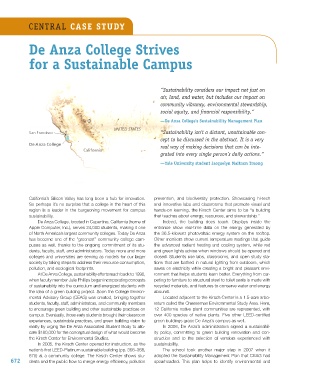Page 673 - Environment: The Science Behind the Stories
P. 673
CEntrAL CaSe StUdy
de anza College Strives
for a Sustainable Campus
“Sustainability considers our impact not just on
air, land, and water, but includes our impact on
community vibrancy, environmental stewardship,
social equity, and financial responsibility.”
— de anza College’s Sustainability Management Plan
UNITED STATES
San Francisco “Sustainability isn’t a distant, unattainable con-
cept to be discussed in the abstract. It is a very
De Anza College real way of making decisions that can be inte-
California
grated into every single person’s daily actions.”
—yale University student Jacquelyn Maitram truong
Pacific
Ocean
MEXICO
California’s Silicon Valley has long been a hub for innovation. prevention, and biodiversity protection. Showcasing hi-tech
So perhaps it’s no surprise that a college in the heart of this and innovative labs and classrooms that promote visual and
region is a leader in the burgeoning movement for campus hands-on learning, the Kirsch Center aims to be “a building
sustainability. that teaches about energy, resources, and stewardship.”
De Anza College, located in Cupertino, California (home of Indeed, the building does teach. Displays inside the
Apple Computer, Inc.), serves 24,000 students, making it one entrance show real-time data on the energy generated by
of North America’s largest community colleges. Today De Anza the 36.5-kilowatt photovoltaic energy system on the rooftop.
has become one of the “greenest” community college cam- Other monitors show current temperature readings that guide
puses as well, thanks to the ongoing commitment of its stu- the advanced radiant heating and cooling system, while red
dents, faculty, staff, and administrators. Today more and more and green lights advise when windows should be opened and
colleges and universities are serving as models for our larger closed. Students use labs, classrooms, and open study sta-
society by taking steps to address their resource consumption, tions that are bathed in natural lighting from outdoors, which
pollution, and ecological footprints. saves on electricity while creating a bright and pleasant envi-
At De Anza College, sustainability efforts reach back to 1990, ronment that helps students learn better. Everything from car-
when faculty member Julie Phillips began incorporating concepts peting to furniture to structural steel to toilet seats is made with
of sustainability into the curriculum and energized students with recycled materials, and features to conserve water and energy
the idea of a green building project. Soon the College Environ- abound.
mental Advisory Group (CEAG) was created, bringing together Located adjacent to the Kirsch Center is a 1.5-acre arbo-
students, faculty, staff, administrators, and community members retum called the Cheeseman Environmental Study Area. Here,
to encourage green building and other sustainable practices on 12 California native plant communities are represented, with
campus. Eventually, those early students brought their classroom over 400 species of native plants. Five other LEED-certified
experiences, sustainable practices, and green building vision to green buildings grace De Anza’s campus as well.
reality by urging the De Anza Associated Student Body to allo- In 2006, De Anza’s administrators signed a sustainabil-
cate $180,000 for the conceptual design of what would become ity policy, committing to green building renovation and con-
the Kirsch Center for Environmental Studies. struction and to the selection of vendors experienced with
In 2005, the Kirsch Center opened for instruction, as the sustainability.
nation’s first LEED-Platinum sustainable building (pp. 366–368, The school took another major step in 2007 when it
675) at a community college. The Kirsch Center shows stu- adopted the Sustainability Management Plan that CEAG had
672 dents and the public how to merge energy efficiency, pollution spearheaded. This plan helps to identify environmental and
M24_WITH7428_05_SE_C24.indd 672 13/12/14 10:40 AM

